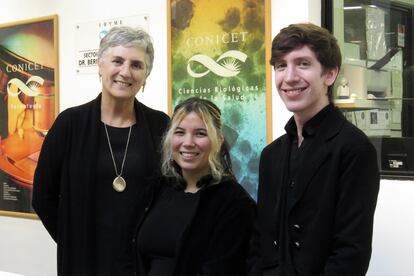Your semen is not immune to climate change
Heat waves reduce the number of motile sperm by up to 10%, according to an Argentine study. ‘Eventually it will be one more variable for planning parenthood,’ says one of the authors of the report

The first piece of the puzzle was Gustavo Luis Verón’s research during his PhD studies, when he analyzed semen quality based on different factors in Argentina. Obesity, age and climatic factors were some of the variables that he investigated. At the end of 2021, the results showed that semen samples generated in the winter were noticeably better quality than those generated in the summer. This information got him obsessed with another question: Could increasing heat waves be putting male fertility in check? The latest findings by Verón and his colleagues seem to indicate so. According to a study published this year in Science Direct, semen samples obtained during heat waves presented 10% fewer motile sperm — the only ones capable of fertilizing an egg — than samples that were never exposed. The high temperatures also affected their morphology.
For Dr. Mónica Vázquez-Levin, principal researcher at the National Scientific and Technical Research Council (Conicet) and another one of the authors of the report, given the frequency and intensity of these weather events, “the climate will eventually be a variable for planning parenthood.”
“It’s a myth that men always have sperm and that the sperm is always good. Men are going to have to start taking measures, and they will end up preserving their sperm at an early age, just as women do today with their eggs,” she adds.
Although there are previous studies reporting a negative association between temperature and semen quality, the focus has been mainly on Asian and European populations and not necessarily on the impact of heat waves. One paper by a group of Chinese academics revealed the impact on bakers and welders. The research by Dr. Verón, genetics graduate Ania Manjon and Dr. Vázquez-Levin is the first report that focuses on the Latin American population and, specifically, the Argentine population.
The team identified an average of 6.5 heat waves annually between 2005 and 2023, the period under study, and an increase of half a degree per decade. Although they recorded 287 days with high temperatures, they focused on episodes of at least three consecutive days between 22ºC (71.6ºF) and 32.3°C (90ºF), based on how the scientific community defines heat waves. The study also estimated an increase of six days of heat waves per decade.

The testicular temperature of mammals is vital for efficient spermatogenesis [the moment when the testicles generate sperm]. The evolutionary transition of the human being required the externalization of the testes precisely as a thermal regulator in practically all mammals, except for some such as elephants. And, consequently, conditions that induce heat stress are associated with a decrease in semen quality. Currently, the World Health Organization (WHO) has issued guidelines for the evaluation of semen that consider the number of sperm, vitality, motility (if and how they move) and morphology, as well as external factors. The last publication, from 2021, did not yet include climatic factors.
In addition to the impact on motile sperm, the scientists noted that the moment in which the heat wave occurs is also very relevant. Men exposed to increases in temperature during spermatogenesis exhibited a lower number of sperm with worse morphology compared to those who suffered the heat wave at the time of ejaculation. In the increasingly distant future, this information could be used to shape a useful medical tool. “One cannot control alone when there is a heat wave or not,” explains Vázquez-Levin, founder and coordinator of AndroLATAM, a network of professionals in Male Reproductive Health in Latin America. “But it can recommend when it is best to try to conceive based on the days that have passed since the hot moments.”
Another variable taken into account by this study carried out with 54,926 men between 18 and 60 years old was age. The results show that men under 40 years of age exposed to heat had a lower volume of semen, although the sperm morphology was normal. Men over 40 also had a lower proportion of live sperm and their morphology was affected. Additional analyses revealed a significantly negative association between semen quality and heat wave length. That is, prolonged exposure is more harmful than acute exposure.
“We know much more about infertility in women than in men. But governments have to make decisions to reverse these climate phenomena, now that we know that they affect them. Because we are talking about the permanence of humans on Earth. There is already literature on the extinction of species due to heat. And we are another species,” said Vázquez-Levin.
The gap in male infertility research was another reason why they decided to address it. Another one was wanting to “remove weight from women’s backpacks.”
“Historically there has been a very big burden on our shoulders. The inability to conceive had always been attributed to women,” says Vázquez-Levin. Science, once again, shows how wrong we were. About 17.5% of the world’s adults (one in six) will be infertile, according to the WHO. Half of these cases will be due to male infertility. “One of the causes that we already know is global warming. The heat waves are going to have an impact on the demographics of the world if we do nothing.”
Sign up for our weekly newsletter to get more English-language news coverage from EL PAÍS USA Edition
Tu suscripción se está usando en otro dispositivo
¿Quieres añadir otro usuario a tu suscripción?
Si continúas leyendo en este dispositivo, no se podrá leer en el otro.
FlechaTu suscripción se está usando en otro dispositivo y solo puedes acceder a EL PAÍS desde un dispositivo a la vez.
Si quieres compartir tu cuenta, cambia tu suscripción a la modalidad Premium, así podrás añadir otro usuario. Cada uno accederá con su propia cuenta de email, lo que os permitirá personalizar vuestra experiencia en EL PAÍS.
¿Tienes una suscripción de empresa? Accede aquí para contratar más cuentas.
En el caso de no saber quién está usando tu cuenta, te recomendamos cambiar tu contraseña aquí.
Si decides continuar compartiendo tu cuenta, este mensaje se mostrará en tu dispositivo y en el de la otra persona que está usando tu cuenta de forma indefinida, afectando a tu experiencia de lectura. Puedes consultar aquí los términos y condiciones de la suscripción digital.
More information
Archived In
Últimas noticias
Welcome to the post-religion era: The idea of Christianity as the absolute truth has become obsolete
‘I thought you would like it’: The risky sexual practice popularized by TV shows and TikTok
The digitalization of tourism: ‘They promise experiences and gave us the worst possible one’
Mexican peso defies uncertainty with forecasts of a new period of stability in 2026
Most viewed
- Sinaloa Cartel war is taking its toll on Los Chapitos
- Reinhard Genzel, Nobel laureate in physics: ‘One-minute videos will never give you the truth’
- Oona Chaplin: ‘I told James Cameron that I was living in a treehouse and starting a permaculture project with a friend’
- Why the price of coffee has skyrocketed: from Brazilian plantations to specialty coffee houses
- Silver prices are going crazy: This is what’s fueling the rally










































